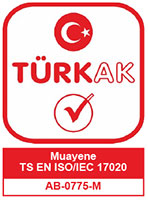Ultrasonic Examination (UT)
1. What is Ultrasonic Testing (UT)?
Ultrasonic testing (UT) is a non-destructive testing method and is performed using high-frequency sound waves (usually between 0.5 MHz and 20 MHz) to detect flaws within a material.
🔧 Basic Principle:
In the UT method, high-frequency sound waves are generated using a probe (transducer) containing a piezoelectric crystal. These waves are transmitted into the material being tested. When a discontinuity in the material's internal structure (e.g., crack, pore, slag, etc.) occurs, the sound waves reflect off this obstacle (creating an echo). These reflected signals, returning to the device, appear as a signal (pulse) on a screen (usually an A-scan).
📡 Equipment Used:
• UT device (electronic signal generator and screen)
• Probe (transducer) – straight, angled, double-crystal, focused, etc.
• Couplant – To transmit sound into the material (gel, oil, water, etc.)
• Reference blocks – Standard blocks for calibration (e.g., V1, V2 blocks – EN 12223)
📏 What is Measured?
• Using the sound transit time (TOF) and signal amplitude, the defect's:
o Depth
o Location
o Magnitude
o Directionality
can be determined.
⚠️ Material Types:
• Metallic materials (steel, aluminum, titanium, etc.)
• Composite materials
• Plastics and some ceramics
However, if the material has a coarse grain structure (e.g., cast iron), the application becomes difficult due to signal absorption.
________________________________________
2. What are the Advantages Compared to Other NDT Methods?
Advantages
High depth perception: It is one of the only methods that can reach deep within the material.
Volumetric flaw detection is possible. : Detects defects such as internal cracks, porosity, and slag, independent of the surface.
Results can be obtained instantly. : Instant evaluation can be made (especially in A-scan mode).
Provides precise measurement. : Defect location, size, and depth can be determined with high accuracy.
Portable and field-compatible. : Suitable for field applications with handheld devices.
Radiation-free. : Does not contain ionizing radiation like X-rays, providing health benefits.
________________________________________
3. What Defects Can This Method Detect?
Ultrasonic testing can detect volumetric and laminar (layered) defects located below the surface.
Detectable Defects
Internal cracks: Internal cracks that can occur in castings and welds.
Lamination (segregation): Layered structures resulting from rolling.
Slag inclusion: Slag trapped within the weld.
Gas voids (porosity): Gas bubbles originating from welding or casting.
Lack of fusion: The inadequate fusion of weld metals.
Out-of-scope geometry differences: Thickness differences, bond adhesion deficiencies (e.g., delamination in composites).
________________________________________
4. What is its Importance in Industry?
Ultrasonic testing is one of the most critical NDT methods in industry. It is particularly important in the following areas:
Sector and Application Areas
Energy and nuclear industry: Pipelines, pressure vessels, turbine blades, reactor equipment.
Petrochemical and refineries: Weld inspections on pipelines, tank hulls, thick-walled components.
Aerospace: Aircraft fuselages, composite structures, titanium and aluminum components.
Railway and shipbuilding: Rails, axles, sheet metal, weld seams.
Steel structures and construction: Bridge elements, crane booms, high-strength structural elements.




